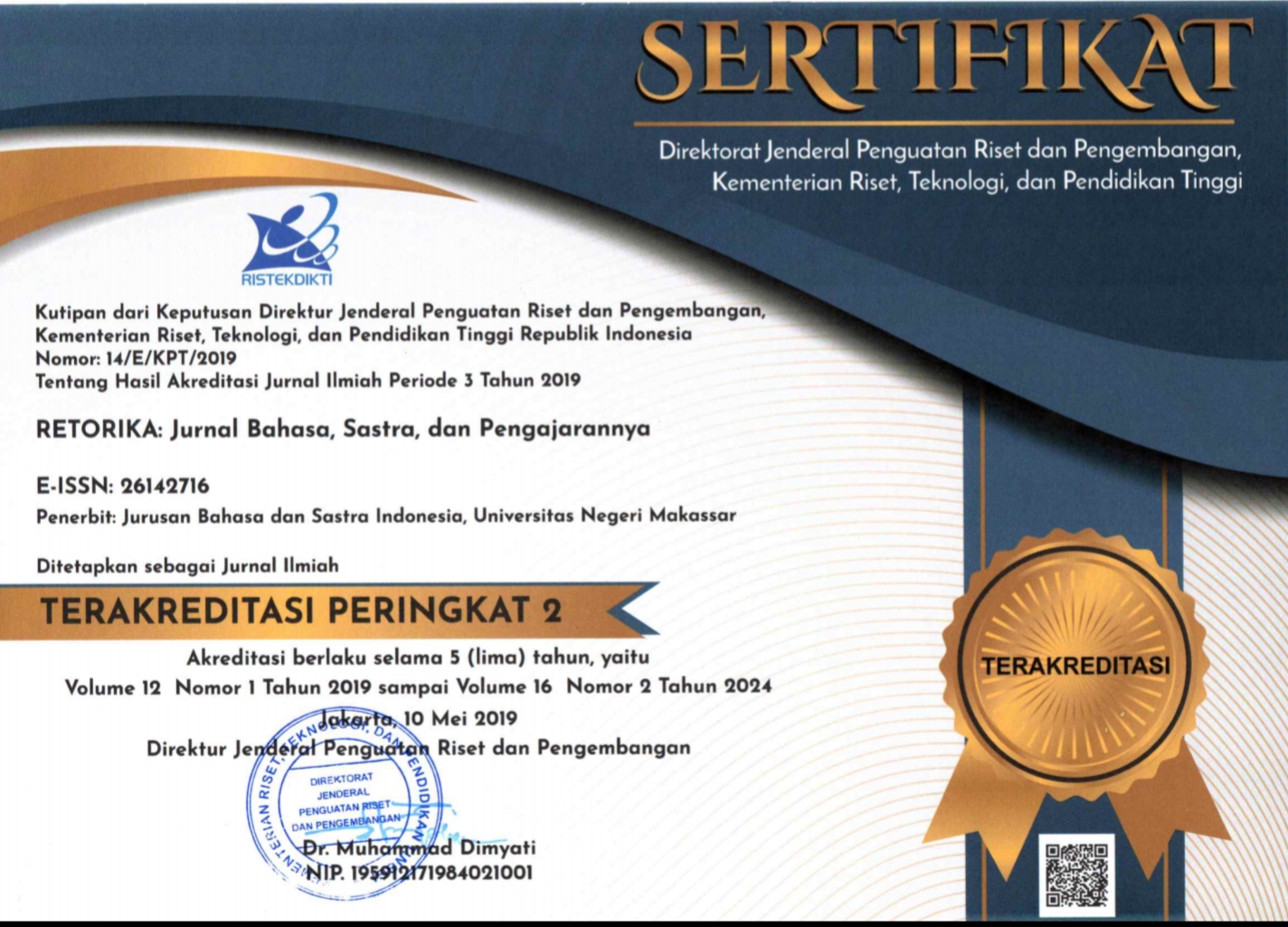PEMANFAATAN TEKNIK AKROSTIK UNTUK MENINGKATKAN KEMAMPUAN MENULIS PUISI SISWA KELAS VIII SMP
(1) Indonesia University of Education
(*) Corresponding Author
DOI: https://doi.org/10.26858/retorika.v11i1.4979
Abstract
Abstract. The Utilization of Acrostic Technique to Increase Student Writing Poetry Skill of Class VIII SMP. This study aims to describe the process and the results of learning to write poetry students by using acrostic techniques. This type of research is a classroom action research consisting of two cycles. Data analysis technique is done descriptively quantitative and qualitative. The subjects of this study are teachers and students of class VIII SMP Negeri 22 Makassar. Based on result of the study found that (1) the mastery of learning shows a quality improvement of 14.8 percent and (2) the result of student writing poetry showed an increase from the average value of 75 in cycle one to 80 in cycle two. Based on these results, acrostic technique is recommended for learning to write poetry in JHS.
Full Text:
PDFReferences
Al-Hajj, I. 2005. Strategi Menulis Puisi Akrostik se-bagai Upaya Meningkatkan Keterampilan Me-nulis Puisi Siswa Kelas VII SMPN 2 Kendari. Tesis. Makassar: UNM.
Atmazaki. 2013. Mengungkap Masa Depan: Inovasi Pembelajaran Bahasa Indonesia dalam Konteks Pengembangan Karakter Cerdas. Makalah. Padang: UNP.
Asri, A. 2017. Korelasi Penguasaan Teori Puisi dengan Keterampilan Menulis Puisi Mahasiswa Program Studi Pendidikan Bahasa dan Sastra Indonesia Fakultas Bahasa san Sastra Univer-sita Negeri Makassar Angkatan 2015. Retorika, 10 (1): 1–7.
Chatib, M. 2011. Gurunya Manusia. Bandung: Kaifa.
Fitri, S. 2017. Peningkatan Kemampuan Menulis Puisi dengan Menggunakan Metode Kooperatif Tipe Think Pair Share (Berpikir, Berpasangan, Dan Berbagi) pada Siswa Kelas VIII SMP Negeri 4 Bulukumba. Retorika, 10 (1): 49–55.
Frye, E. M., W. Trathen, & B. Schlagal. 2010. “Extending Acrostic Poetry Into Content Learning: A Scaffolding Framework”. The Reading Teacher, 63 (7): 591–595.
Harley, A., & Noyes, D. 2009. African Acrostics: A Word In Edgeways. Somerville, MA: Cand-lewick. Frye, Elizabeth M., Woodrow Trathen, & Bob Schlagal. 2010. Extending Acrostic Poetry Into Conten Learning: A Scaffolding Framework. The Reading Teacher. 63 (7): 591–595.
Herawati. 2010. Penerapan Penggunaan Strategi Akrostik dalam Pembelajaran Menulis Puisi Siswa Kelas VIII SMP Negeri 1 Bontomatene Kabupaten Selayar. Skripsi. Makassar: FBS UNM.
Nurgiyantoro, B. & A. Efendi. 2013. Prioritas Penen-tuan Nilai Pendidikan Karakter dalam Pembel-ajaran Sastra Remaj. Cakrawala Pendidikan, 32 (3): 382–393.
Article Metrics
Abstract view : 1305 times | PDF view : 376 timesRefbacks
- There are currently no refbacks.
Copyright (c) 2018 Nurul Khairani Abduh

This work is licensed under a Creative Commons Attribution-NonCommercial 4.0 International License.
Published by:
Department of Indonesian Language, Faculty of Languages and Literature, Universitas Negeri Makassar in cooperate with Asosiasi Dosen Bahasa dan Sastra Indonesia (ADOBSI) and Ikatan Program Studi Pendidikan Bahasa dan Sastra Indonesia (IKAPROBSI).
Address: Department of Indonesian Language Office, DG Building Second Floor, UNM Parangtambung, Daeng Tata Raya Street, Makassar, South Sulawesi, Indonesia
 Email: retorika@unm.ac.id
Email: retorika@unm.ac.id

RETORIKA: Jurnal Bahasa, Sastra,dan Pengajarannya is licensed under a Creative Commons Attribution-NonCommercial 4.0 International License.
















